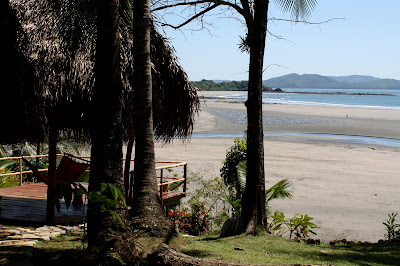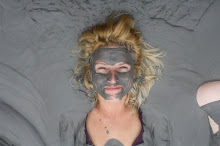Panama part 3 – Surfing Meditation in Santa Catalina
A big part of the reason I wanted to go to Panama was to surf. The supposedly best place to surf in Panama is Santa Catalina, and although it was far away, and kind of hard to get to, I just had a feeling it’d be worth it. I was not wrong.
It took several modes of transportation and about 8 hours to get there. When I finally arrived, it felt more like I was on a farm than at a beach. It did not have the feeling of a surf town, but rather a farm that seemed miles away from the ocean, although it was actually right on the ocean. I had read that the hotels and hostels were off a dirt road. Somehow I pictured them being close together overlooking the Pacific, but they weren’t.
The first place I stayed was a 20-minute walk down a hot and dusty dirt road to get to the surf beach. Although I enjoyed my room and the company of the people I met there (especially when we were playing with people in hammocks much like one would with the 5 silver balls on string that only move the end two balls – the people in hammock/silver ball theory), it was very far to get from my hostel to anywhere. The first night I walked back from dinner in the dark with a dim flashlight, alone, down one dirt road to another dirt road and I slipped and squished around into a few thick mud puddles on the way. Mud got into an open blister on my foot and I arrived at the hostel to find there was no water. I moved the next day to a place overlooking the Pacific. My room here was a basic bamboo hut, with no lock and my key was a piece of wire to wrap around the hasp to keep the door shut. No need for high security, everything remained completely safe.
 My bamboo hut room overlooking Playa Estero
My bamboo hut room overlooking Playa Estero
Look at the view!
 From Rancho Estero my view of Playa Estero at low tide
From Rancho Estero my view of Playa Estero at low tideThe beach for me to surf on was not the challenging rock bottom of Santa Catalina itself, but rather the much more forgiving sand bottom beach of Playa Estero. Estero had only one place to stay on the beach itself with a restaurant and, thankfully, a place to rent surf boards aptly called the Oasis.
 The Oasis is behind those palm trees. This is the view looking back at low tide.
The Oasis is behind those palm trees. This is the view looking back at low tide.Much of life here depended upon
la marea – the tides (reminiscent to Playa Sámara in Costa Rica for me in this way and this way alone). During my stay was a full moon and the fluctuation of the tides on the beach was probably more than 100 meters each way, making the beach very wide with tiny waves, or very narrow with slightly larger waves. There was a stream at the beginning of the beach that changed rather dramatically in width and depth. During low tide it was about a foot across and a few inches deep. During high tide it was about 50 feet wide, the center of the crossing was over my head, and it had a current. This made getting to or from the beach an undertaking during high tides. For this reason I do not have many pictures, for fear of my camera getting wet. I am also lacking pictures of high tide, because that's when I was surfing.
 Low tide view from the hammock
Low tide view from the hammock During low tide, it was time for hanging out and talking, braving the long, hot walk to town for a meal, playing Frisbee, walking, reading on the beach, or swimming. During high tide, it was time to surf. There is not a lot to do in Santa Catalina besides the aforementioned activities, nor are there a lot of people. It is rustic, basic, and definitely not for everyone, but I absolutely loved it there. I ended up staying longer than I planned and I am quite glad for that.
The first day I was there I met a woman named Kristina from Canada. She was vacationing there with her husband George and 2 year-old daughter named Lucia. The adults were both surfers, had been there before, and had been working on a boat on which they wanted to move and live in Panama. My second day there I rented the only long-ish board available. It was 7’6” and called a “fun board”. The fun board length was a bit shorter board than I was used to. At first I wasn’t sure if I’d be able to do it, but I got used to the length quickly and it was…well…fun! Kristina and two women from San Francisco and I surfed together. There were a bunch of Panamanian surfers as well, as it was Sunday just post the New Year. Everyone seemed friendly, encouraging, and relaxed on Playa Estero. I heard that it was a bit more competitive on Playa Santa Catalina. We surfed until the sunset.
That evening I stayed down on the beach and had an Italian dinner (the Oasis is owned and run by an Italian family) with Kristina, George, and Lucia. After dinner it was dark and I had to ask someone with a flashlight to help me find my way across the stream and back up the hill to my hostel. From that day forward I always carried my flashlight to the beach no matter what the hour.
The tide unfortunately stayed out later and later each day, but at the same time the waves were increasing in size. It was time to relax, read, and reflect. The vacationing Panamanians returned to work and suddenly the beach was remarkably devoid of people.
 One of the few people on Playa Estero
One of the few people on Playa Estero
One night after dinner and wine with Kristina and George a group of Argentinians were having a bonfire on the beach. I joined them in the for
una cerveza, and some star gazing. It was definitely feeling more and more like a tropical vacation in paradise.
George had told me that because they were taking care of a 2 year-old that Kristina and he would not be able to surf together. He said I could borrow one of their boards if I wanted. I offered to watch Lucia if they wanted to surf together. It was late in the afternoon and George had returned from surfing at Santa Catalina and I took him up on the offer of his board. I used his board, which was 6’8”. At first it felt kind of wobbly and small, but then I ended up loving it. It was my favorite day of surfing in Panama. Ben, a guy from my hostel and I were surfing and laughing together. The waves were not large and were fairly easy to catch. There was a lull between the waves and it was meditative to do nothing but be exactly where I was, taking in the view, the ocean scent, my burning eyes, and beautiful sunset. Again, we surfed until the sun went down and then made the difficult river crossing back up to the hostel. I learned to shower, change back into my bathing suit for the river crossing, but bring some dry clothes in a bag down with me.
The last day there Ben and I surfed together again. I rented a board that was also 6’8” and decided that 6'8" was
mi tabla preferida – surfboard of choice. There was a rather pompous Canadian guy that lived there, who kept giving me unsolicited surfing advice that made me miss the gentle instruction of Yoyi. I realized while in Panama that Yoyi had taught me a lot about surfing that I used every time I was in the waves.
After dinner and a short walk on the beach at night to see the stars and say goodbye, early the next morning Ben and I were off to Playa Venao.
Adios Santa Catalina. Me gustaria regresar con amigos para surfiar otra vez.














































